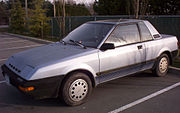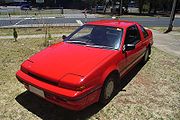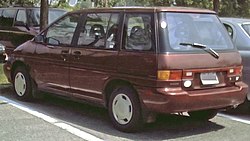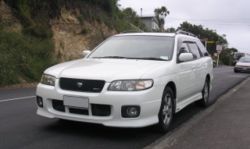The
Nissan Pulsar is a
compact car/
small family car produced by the Japanese automaker
Nissan since 1978 when it debuted as a
subcompact car. It was originally conceived as a replacement for Nissan's first front-wheel drive platform, the
Nissan Cherry family (models E10 and F10). So the Pulsar was actually the third-generation
FF layout Nissan. All Pulsar models were produced in a
front-wheel drive configuration, though from the 1980s, Nissan did offer
four-wheel drive models, and in the early 1990s, the four-wheel drive
turbocharged Nissan Pulsar
GTI-R.
N10 series (1978-1982)

Datsun 310 5-door (US)
The Pulsar was first released in 1978 and was a subcompact car as was the Nissan Cherry it replaced. The N10 series Pulsar was exported to Australia with the Datsun Pulsar name. This model was known as the Datsun Cherry or Datsun 100A/120A/130A/140A/150A in Europe and the Datsun 310 in the U.S.. In Canada, the Datsun 310 was available with "Pulsar" striping on the rear quarters. The Nissan Langley, from 1980, was a more upmarket Pulsar.
The Pulsar was available as a three or five-door hatchback, four-door sedan, a two or four-door van or station wagon, a two-door fastback with wraparound rear window, and a short-lived four-door fastback.
A mid-term facelift brought new E-series engines for 1981 and 1982.
N12 series (1983-1986)

1982-1987 Nissan Pulsar GL (N12)
A more angular version was announced in mid-1982. This model was also built in Italy by Alfa Romeo as the Arna (named after the joint venture which created it, Alfa Romeo Nissan Autoveicoli), using Alfa Romeo engines. Confusingly, the Italian models were also sold with Nissan badges, in Japan as the Nissan Pulsar Milano and in Europe as the Nissan Cherry Europe. At Alfa Romeo, the Arna was meant to replace lesser versions of the popular Alfasud, but never had the Italian car's appeal. The Cherry Europe also failed spectacularly in its home market - lacking the build quality and reliability of its Japanese built sister car, yet at the same time managing to inherit the typical 1980s Alfa vulnerability to body corrosion.
By this time, Nissan had more or less standardized its naming policy worldwide, so as a Nissan it tended, with few exceptions, to be known as a Pulsar.
Those exceptions included related models in the Japanese home market. The Nissan Langley was a Pulsar with more powerful engines and four headlights. The Nissan Liberta Villa was a four-door version. The Nissan Pulsar EXA was a two-door coupé version with pop-up headlights.

1986 Nissan Pulsar NX (North American Model)
The Pulsar EXA was known in North America as the Pulsar NX and shared many of its parts with the Nissan Sentra. This version of the Pulsar NX was available from 1983 to 1986 and came with either the fuel injected turbocharged E15ET engine or the carbureted naturally-aspirated E16S engine. The Langley was built in Australia as the Nissan Pulsar, while the more standard Pulsar appeared there as the Holden Astra. The three-door and five-door hatchback versions of the Pulsar were also made available, replacing the old Datsun 310 hatchbacks, but they proved to be unpopular and they were withdrawn from Nissan's North American lineup after one year. The five-door hatchback remained in Australia until 1987, where it was known as the Pulsar ET Turbo and featured the E15ET engine.[citation needed]
Pulsar EXA Convertible - This limited edition model was designed to commemorate the 15th anniversary of Nissan Cherry dealerships. It was launched in May, 1985, and just 100 vehicles were made available for the whole of Japan. The vehicle sports numerous special accessories, including a soft top made from a special insulating material to keep out the rain and heat, and a rear window made from organic glass to ensure high visibility.
N13 series (1987-1990)

1987-1990 Pulsar NX / EXA

1988 Pulsar Vector SVD

Australian N13 Pulsar GX Hatch

Australian 1990 N13 Pulsar GL Hatch(16lf)
In 1986, Nissan's design chief refused to follow the smoother, aerodynamic look of other cars. A squarer Pulsar (N13 series) was released as a result; innovations included a four-wheel drive model. The Pulsar–Astra relationship continued in Australia, with the Langley sold as the Pulsar there and the four-door sedan version of the Nissan called the Pulsar Vector. The Langley also continued sales in Japan as a "Japanese-spec" Pulsar with a more powerful DOHC 1.8 L engine as opposed to its SOHC counterpart in Australia. The N13 Langley featured other options such as a limited-slip differential, luxurious interior and the much sought-after black headlights, center grille and round Skyline-style taillights. In countries such as New Zealand, the Sunny and Pulsar were combined into a single model, the Nissan Sentra — which differed (apart from the station wagon) from the models sold under the same name in the United States.
Versions in the United Kingdom were:
- 1.3 L (57 kW@5000 rpm)
- 1.3 LS (57 kW@5000 rpm)
- 1.3 GS (57 kW@5000 rpm)
- 1.3 LX (59 kW@5150 rpm)
- 1.4 LS (64 kW@5000 rpm)
- 1.4 GS (64 kW@5000 rpm)
- 1.6 LX (69 kW@4800 rpm)
- 1.6 SLX (75 kW@5300 rpm)
- 1.6 GSX (86 kW@5800 rpm)
- 1.8 ZX (98 kW@5000 rpm)
- 1.8 GT. (169 kW@6200 rpm)
Engines offered in the Australian built version were:
- 1.6L GM Family II 16LF, 1598 cc, single point TBI, SOHC, 56 kW (75 hp)@5600 rpm, 125 N·m (92 ft·lbf)@3600 rpm
- 1.8L GM Family II 18LE, 1796 cc, multi point EFI, SOHC, 79 kW (106 hp)@5600 rpm, 151 N·m (111 ft·lbf)@3600 rpm
- 1.8L GM Family II 18LE, 1796 cc, multi point EFI, SOHC, 84 kW (113 hp)@5600 rpm, 162 N·m (119 ft·lbf)@3600 rpm (SVD)
Saloon models were badged as Pulsar; this was the basis for the badge-engineered Holden Astra.
In Europe, it was sold as the Nissan Sunny, unrelated, however, to the Sunny sold in Asia. In Malaysia, it was sold as the Nissan Sentra, differ from the Nissan Sentra sold in the America. In South Africa it was sold as the Nissan Sabre. There were three and five-door hatchbacks and a four-door sedan.
The EXA was spun off as its own model, with an innovative modular rear end: customers could opt for a coupé, hatchback or an open-top car depending on what they put on. This version was actually based on the North American B12 "Sentra" chassis, and was equipped with the 1.8L CA18DE engine (93 kW @ 6400 rpm, 156 N·m (115 ft·lbf) @ 4800 rpm), as found in the S13 Nissan Silvia. This version of the EXA was available in North America under the name Pulsar NX and was sold from 1987 to 1990. The EXA/Pulsar NX was replaced in 1991 with the Nissan NX coupe.
N14 series (1991-1994)

Nissan Pulsar (N14)
In 1990, the N14 model finally saw Nissan conform to the rounded look. There was no Holden equivalent. It continued to be offered in New Zealand as the Sentra. In Europe, the Sunny name continued, applied to three, four and five-door models, alongside the Sunny California station wagon from Japan (called either the Sunny Estate or Sunny Traveller). The Langley and Liberta Villa models were not offered. There was no N14 Pulsar offered in the US either; Instead, the US Pulsar evolved into what was known as the NX1600 with the GA16DE engine or the NX2000 with the SR20DE engine and rear disc brakes. 1994 was the last year for the N chassis in the US.
This generation was badged as the Nissan Sabre in South Africa, and the Nissan Sunny in Europe. The Pulsar was Wheels magazine's Car of the Year for 1991.
The N14 series also saw the introduction of the Nissan Pulsar GTI-R (labelled Sunny GTI-R in Europe). This was a homologation variant produced to satisfy the necessary WRC rules at that time. It featured a turbocharged SR20DET engine producing 169 kW (230 hp JIS) of power, as well as the ATTESA all-wheel drive system.
The GTI-R, which was identified as an RNN14 model, was entered by Nissan into the World Rally Championship. However, it did not prove to be very competitive, and many believe it was hampered by a few technical problems. These included excessive weight over the front wheels which caused a deficiency in handling where the car could understeer excessively and the location of the turbocharger's intercooler unit atop the engine which caused inefficiency in the induction system. Many also thoerised that the cars were running with a manufacturer of tyres that were not up to scratch with the competition at that time. The GTI-R raced under the Nissan Motorsport Europe banner. It was more competitive in the hands of privateers, winning the Group N class of the World Championship in the hands of Grégoire de Mévius. It also proved popular in the European Rallycross Championship.
N15 series (1995-1999)

1997 Nissan Pulsar
In 1995, the N15 Pulsar was launched and sold in Europe as the Nissan Almera. New Zealand Sentras changed names (to Pulsar) during this generation as local assembly of the range ceased in favour of imports from Japan. Again, three, four and five-door models were offered. However, in Australia, the N15 Pulsar was sold as a 5-door hatchback and four door sedan only. The Australian versions included the LX, SLX, Q and SSS. The SSS model (hatch only) featured the SR20DE engine featuring 105 kW (141 hp)/179 Nm. The station wagon continued to be from the Sunny, later spun off in Japan into the Nissan Wingroad.
Configurations:
N15 Pulsars came with the following engines in Japan:
GA15DE - There was a 4-wheel drive variant of the GA engine series in some N15 Pulsars
GA16DE
SR18DE - JDM 'Serie GTi's came with a 1.8 litre engine
SR16VE - NEO VVL (Nissan Ecologically Orientated Variable Valve Timing and Lift) engine used in the 'Serie VZ-R'
SR16VE N1 - Used in the VZ-R N1, which was a racing homologation version intended to compete with the Honda Civic Type-R. Producing 200 PS (197 hp/147 kW) from its 1.6 L SR16VE engine, it claimed the highest specific output for a production car prior to the introduction of the Honda S2000.
N16 series (2000-2005)

2004 Nissan Pulsar 1.8 Super Saloon N16
In 2000, Nissan launched the N16 Pulsar, which included a compact MPV version (the Nissan Almera Tino or Nissan Tino) for the first time. The Wingroad continues to be sold as the Pulsar Wagon or Almera Traveller in many countries. To keep the Bluebird nameplate alive, Nissan shifted it to the four-door version of the Pulsar, and named it the Nissan Bluebird Sylphy in Japan. Unlike other Pulsars, the Bluebird Sylphy has a chrome grille.
In the Philippines and Taiwan, the Bluebird Sylphy is sold as the Nissan Sentra. In New Zealand and Thailand, the five-door Pulsar is imported from the UK, while the four-door model is essentially a rebadged Bluebird Sylphy. Consequently, each body style has a different front end.
In Thailand and China, the N16 Bluebird Sylphy is sold as the Nissan Sunny.
In Indonesia, the Bluebird Sylphy is known as Sentra 1.8 Super Saloon. This model is for private use and sold between 2002 and 2004. The facelifted 2005 - 2006 model N16 is Sunny Neo 1.6, and intended for taxi use only.
Australia (2000-2005)
In Australia, as with New Zealand, it is marketed as a hot hatch rather than a small family car. This model was known, in Nissan terminology, as the N16. A four-door sedan and a five-door hatchback are offered.
Trim levels are LX, ST, Q and Ti. Engine choices consisted of a 1.6-litre or a 1.8-litre four-cylinder with 16 valves. Power output was 83 kW 118 hp and 92 kW (123 hp).
The four-door was available in four trim levels - an LX with the 1.6, the ST and Ti with the 1.8-litre engine as standard, and a Q version with the 1.8 motor and a sportier level of trim, including a rear spoiler and alloy wheels.
In the five-door range there was no LX version, this being four-door only. Nissan launched the hatchback model with the ST trim level and a sporty Q version. As such, all hatches were 1.8-litre powered. The base-model LX sedan came with a driver's airbag, air-conditioning, remote locking and power mirrors, although no anti-lock brakes (ABS) or power windows were offered. Surprisingly, the ST five-door gained an extra front airbag, whereas the four-door model did not have one as standard.
In Ti form, the four-door gained both front airbags, ABS, climate-control air-conditioning, alloy wheels and power windows. The Q model was similar to the Ti four-door, although there were slight discrepancies between the sedan and hatch, with the latter version gaining an extra air-bag and 15-inch alloy wheels versus the 14-inch alloys on the sedan.
The future
- In October 2005, a new Nissan Bluebird Sylphy (G11 series) was previewed and appeared at the Tokyo Motor Show.
- In Europe, Nissan is expected to replace the Pulsar with models based on the Renault Clio, in particular niche vehicles such as the Nissan Note.
- In Japan, the Nissan Tiida hatchback and Tiida Latio sedan replaced the Pulsar in 2004. The Tiida range was introduced in Australia and New Zealand in early 2006, and also the United States, as the Versa.
- In 2005 a concept car called the Nissan AZEAL debuted at the Detroit Auto Show. The Azeal, an affordable front wheel drive sport coupe aimed at the youth market, is best described as a successor to the Pulsar NX.
































![Validate my RSS feed [Valid RSS]](valid-rss-rogers.png)














































































